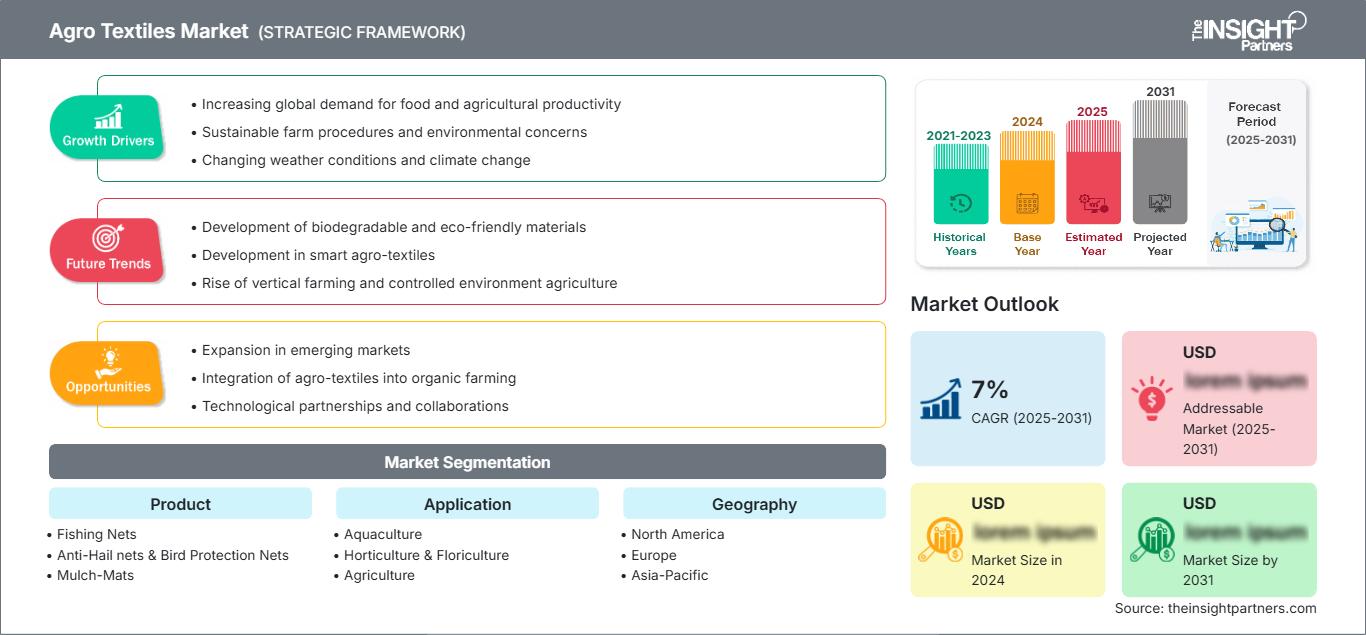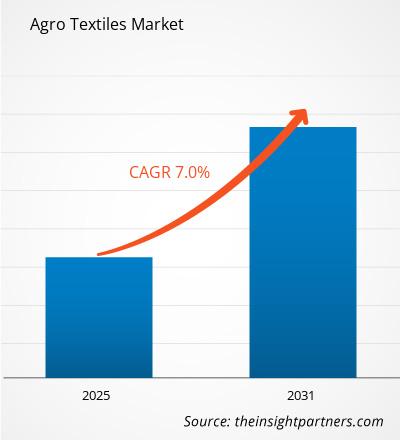Le marché des textiles agricoles devrait enregistrer un TCAC de 7 % entre 2025 et 2031, avec une taille de marché passant de XX millions de dollars américains en 2024 à XX millions de dollars américains d'ici 2031.
Le rapport est segmenté par produit (filets de pêche, filets anti-grêle et filets de protection contre les oiseaux, paillis, filets d'ombrage et autres). Le rapport présente également une analyse basée sur l'application (aquaculture, horticulture et floriculture, agriculture et autres). L'analyse mondiale est ensuite ventilée au niveau régional et par principaux pays. La taille du marché et les prévisions aux niveaux mondial, régional et national pour tous les segments de marché clés sont couvertes dans le cadre du rapport. Le rapport indique la valeur en USD pour l'analyse et les segments ci-dessus. Français Le rapport fournit des statistiques clés sur l'état du marché des principaux acteurs du marché et offre des tendances et des opportunités de marché.
Objectif du rapport
Le rapport sur le marché des textiles agricoles de The Insight Partners vise à décrire le paysage actuel et la croissance future, les principaux facteurs moteurs, les défis et les opportunités. Cela fournira des informations à diverses parties prenantes commerciales, telles que :
- Fournisseurs de technologies/Fabricants : Pour comprendre l'évolution de la dynamique du marché et connaître les opportunités de croissance potentielles, leur permettant de prendre des décisions stratégiques éclairées.
- Investisseurs : Pour mener une analyse complète des tendances concernant le taux de croissance du marché, les projections financières du marché et les opportunités qui existent tout au long de la chaîne de valeur.
- Organismes de réglementation : Pour réglementer les politiques et surveiller les activités du marché dans le but de minimiser les abus, de préserver la confiance des investisseurs et de maintenir l'intégrité et la stabilité du marché.
Segmentation du marché des textiles agricoles Produit
- Filets de pêche
- Filets anti-grêle et filets de protection contre les oiseaux
- Tapis de paillis
- Filets d'ombrage
Application
- Aquaculture
- Horticulture et floriculture
- Agriculture
Vous bénéficierez d’une personnalisation sur n’importe quel rapport - gratuitement - y compris des parties de ce rapport, ou une analyse au niveau du pays, un pack de données Excel, ainsi que de profiter d’offres exceptionnelles et de réductions pour les start-ups et les universités
Marché des textiles agricoles: Perspectives stratégiques

- Obtenez les principales tendances clés du marché de ce rapport.Cet échantillon GRATUIT comprendra une analyse de données, allant des tendances du marché aux estimations et prévisions.
Facteurs de croissance du marché des agrotextiles
- Demande mondiale croissante en produits alimentaires et productivité agricole : La demande mondiale en produits alimentaires augmente et constitue donc l'un des principaux moteurs du marché des agrotextiles. La population augmente ; par conséquent, la demande pour une productivité agricole plus élevée continue d'augmenter. Les agrotextiles tels que les filets, les matériaux d'ombrage et les films de paillage contribuent à optimiser la production agricole en protégeant les cultures des parasites, des maladies et des conditions météorologiques extrêmes. Ils sont également utilisés pour réguler la température et l'humidité afin de créer un environnement propice à la croissance des plantes. C'est ce qui explique l'adoption des agrotextiles et leur établissement dans le monde entier.
- Procédures agricoles durables et préoccupations environnementales : La durabilité devenant progressivement le mantra de l'agriculture, les agrotextiles commencent à être vus comme une évidence. Par exemple, les films de paillage biodégradables remplacent les films de paillage en plastique conventionnels, réduisant ainsi les déchets plastiques dans les champs agricoles. Dans le cadre d'une agriculture économe en ressources, ces agrotextiles, complétés par des filets antiparasitaires et des toiles d'ombrage, visent à réduire la dépendance aux pesticides et engrais chimiques, dont l'utilisation nuit à l'environnement. Face à la demande croissante d'une agriculture respectueuse de l'environnement, les agrotextiles sont de plus en plus utilisés pour en faire des alternatives viables à une agriculture économe en ressources.
- Changement des conditions météorologiques et changement climatique : Le changement climatique continue de compromettre la régularité et l'intensité des phénomènes météorologiques, notamment les sécheresses, les inondations et les températures extrêmes. La solution essentielle pour prévenir ces catastrophes environnementales réside dans les agrotextiles, ou filets de protection, toiles d'ombrage, couvertures résistantes aux intempéries, etc. Ces structures peuvent servir de dispositifs de protection contre les conditions environnementales défavorables, en maintenant l'humidité du sol et en régulant la température. L'incidence accrue des conditions météorologiques extrêmes signifie donc que les agrotextiles seront de plus en plus nécessaires, offrant des approches innovantes et très pratiques pour répondre à la variabilité climatique.
Tendances futures du marché des agrotextiles
- Développement de matériaux biodégradables et écologiques : Le développement durable est devenu l'un des sujets les plus importants de l'agriculture à l'heure actuelle et dominera certainement le futur marché mondial des agrotextiles. On s'attend à ce que l'industrie agrotextile entre « bientôt » dans le giron de l'industrie agrotextile en s'orientant vers des matériaux biodégradables et écologiques. L'ensemble du secteur a pris conscience de l'intérêt de ces agrotextiles biodégradables (films d'écran et de paillage, filets fabriqués à partir de fibres naturelles ou de polymères biodégradables) car ils réduiraient presque automatiquement l'empreinte environnementale des opérations agricoles. Ils réduisent l'accumulation de déchets plastiques en se décomposant plus tard après leur utilisation pendant la production. On estime que le développement et l'adoption continus de ces agrotextiles devraient fortement influencer le marché.
- Développement des agrotextiles intelligents : Un autre effet significatif sur l’avenir du marché réside dans l’inclusion technologique des agrotextiles. Progressivement, les agrotextiles intelligents, ou textiles capables de détecter et de réagir aux changements des conditions environnementales, seront de plus en plus utilisés. Ces types de vêtements seront conçus avec des capteurs qui mesurent l’humidité et la température du sol, ainsi que des données relatives aux parasites, permettant aux agriculteurs d’évaluer les besoins en irrigation et en lutte antiparasitaire en fonction des performances des cultures. En ce qui concerne l’agriculture de précision et l’agriculture numérique, on peut penser qu’une telle intégration ne fera que se renforcer à mesure que les agrotextiles intelligents se généraliseront.
- Ascension de l’agriculture verticale et de l’agriculture en environnement contrôlé : De tels changements dans l’environnement dus aux courants contrôlés par l’agriculture ouvrent de nouvelles perspectives aux agrotextiles à l’échelle mondiale. Avec l’urbanisation croissante et la diminution des terres arables, l’agriculture verticale – qui consiste à faire pousser de la végétation en couches empilées – ou dans des environnements contrôlés devient une réalité pour la plupart. Les agrotextiles, notamment les films réfléchissants, les matériaux bloquant les UV et les tissus thermorégulateurs, contribuent tous à ces systèmes en créant des conditions de croissance optimales. Avec l'acceptation croissante de ces systèmes de culture, il y aura une demande pour des agrotextiles plus spécialisés, spécialement conçus pour l'agriculture verticale et l'agriculture en environnement contrôlé.
Opportunités de marché pour les agrotextiles
- Expansion sur les marchés émergents : C'est certainement vrai, car si l'Asie-Pacifique, l'Afrique et l'Amérique latine sont en transition, elles offrent le plus grand potentiel pour le marché mondial des agrotextiles. La plupart de ces pays dépendent de l'agriculture et se tournent désormais vers les agrotextiles pour améliorer le rendement des cultures et faire face aux autres chocs climatiques auxquels les agriculteurs sont confrontés. La demande accrue d'agrotextiles devrait provenir de l'essor de l'agriculture moderne et des pratiques durables des agriculteurs, en particulier dans ces régions. Les gouvernements qui encouragent et subventionnent les pratiques agricoles durables et la sécurité alimentaire dans les économies en développement tendent à favoriser encore davantage la croissance du marché.
- Intégration des agrotextiles dans l'agriculture biologique : De nos jours, l'agriculture biologique est rapidement adoptée en raison de sa popularité auprès des consommateurs qui ont développé une conscience beaucoup plus élevée de l'utilisation des pesticides dans les aliments et, par conséquent, une tendance vers les produits biologiques. Les autres fonctions principales des agrotextiles dans l'agriculture biologique sont la lutte contre les nuisibles, la protection des sols et la rétention d'humidité des cultures sans produits chimiques. Cette pratique croissante de l'agriculture biologique dans le monde est la principale opportunité pour le marché des agrotextiles. L'augmentation de l'agriculture biologique augmenterait la demande d'agrotextiles pour l'agriculture biologique. Cela représenterait une niche importante pour les fabricants d'écotextiles.
- Partenariats et collaborations technologiques : Il s'agit encore de l'une des principales opportunités de marché pour les producteurs d'agrotextiles et les développeurs de technologies. L'intégration de nouveaux matériaux, comme les tissus intelligents et les textiles à nano-revêtement, enrichirait également les fonctionnalités et les performances des agrotextiles. De telles collaborations pourraient créer des textiles capables de conserver une grande capacité de rétention d'eau, d'offrir une protection contre les UV et d'être équipés de capteurs pour une meilleure surveillance des cultures grâce aux entreprises technologiques. Ces partenariats entre fabricants de textiles et entreprises technologiques constitueront une voie majeure d’innovation et d’expansion du marché à mesure que la demande en agro-textiles multifonctionnels de haute technologie s’intensifie.
Aperçu régional du marché des textiles agricoles
Les tendances régionales et les facteurs influençant le marché des textiles agricoles tout au long de la période de prévision ont été analysés en détail par les analystes de The Insight Partners. Cette section aborde également les segments et la géographie du marché des textiles agricoles en Amérique du Nord, en Europe, en Asie-Pacifique, au Moyen-Orient et en Afrique, ainsi qu'en Amérique du Sud et en Amérique centrale.
Portée du rapport sur le marché des textiles agricoles
| Attribut de rapport | Détails |
|---|---|
| Taille du marché en 2024 | US$ XX million |
| Taille du marché par 2031 | US$ XX Million |
| TCAC mondial (2025 - 2031) | 7% |
| Données historiques | 2021-2023 |
| Période de prévision | 2025-2031 |
| Segments couverts |
By Produits
|
| Régions et pays couverts | Amérique du Nord
|
| Leaders du marché et profils d'entreprises clés |
|
Densité des acteurs du marché des textiles agricoles : comprendre son impact sur la dynamique des entreprises
Le marché des textiles agricoles connaît une croissance rapide, porté par une demande croissante des utilisateurs finaux, due à des facteurs tels que l'évolution des préférences des consommateurs, les avancées technologiques et une meilleure connaissance des avantages du produit. Face à cette demande croissante, les entreprises élargissent leur offre, innovent pour répondre aux besoins des consommateurs et capitalisent sur les nouvelles tendances, ce qui alimente la croissance du marché.

- Obtenez le Marché des textiles agricoles Aperçu des principaux acteurs clés
- Analyse historique (2 ans), année de base, prévision (7 ans) avec TCAC
- Analyse PEST et SWOT
- Taille du marché Valeur / Volume - Mondial, Régional, Pays
- Industrie et paysage concurrentiel
- Ensemble de données Excel
Rapports récents
Témoignages
Raison d'acheter
- Prise de décision éclairée
- Compréhension de la dynamique du marché
- Analyse concurrentielle
- Connaissances clients
- Prévisions de marché
- Atténuation des risques
- Planification stratégique
- Justification des investissements
- Identification des marchés émergents
- Amélioration des stratégies marketing
- Amélioration de l'efficacité opérationnelle
- Alignement sur les tendances réglementaires




















 Obtenez un échantillon gratuit pour - Marché des textiles agricoles
Obtenez un échantillon gratuit pour - Marché des textiles agricoles